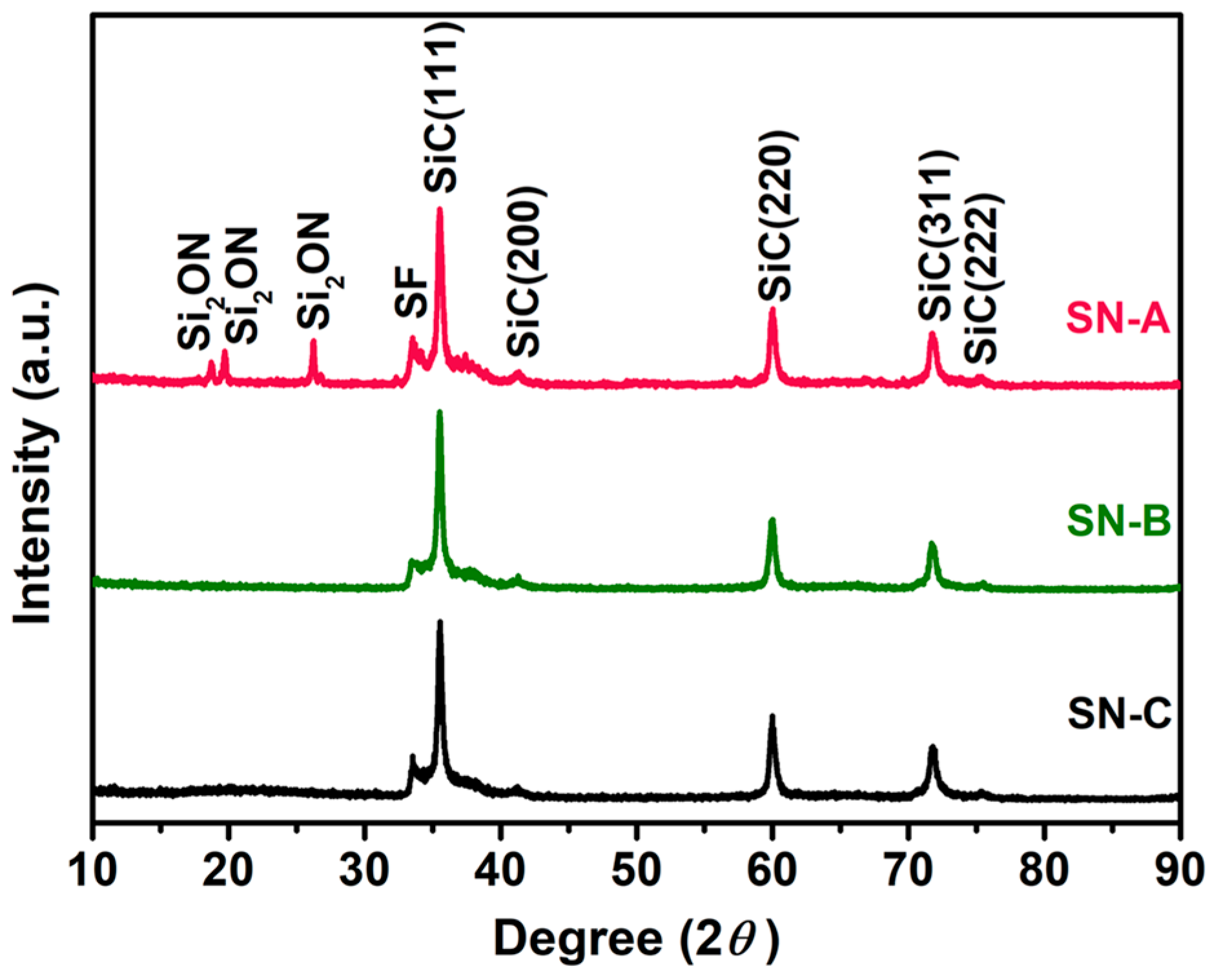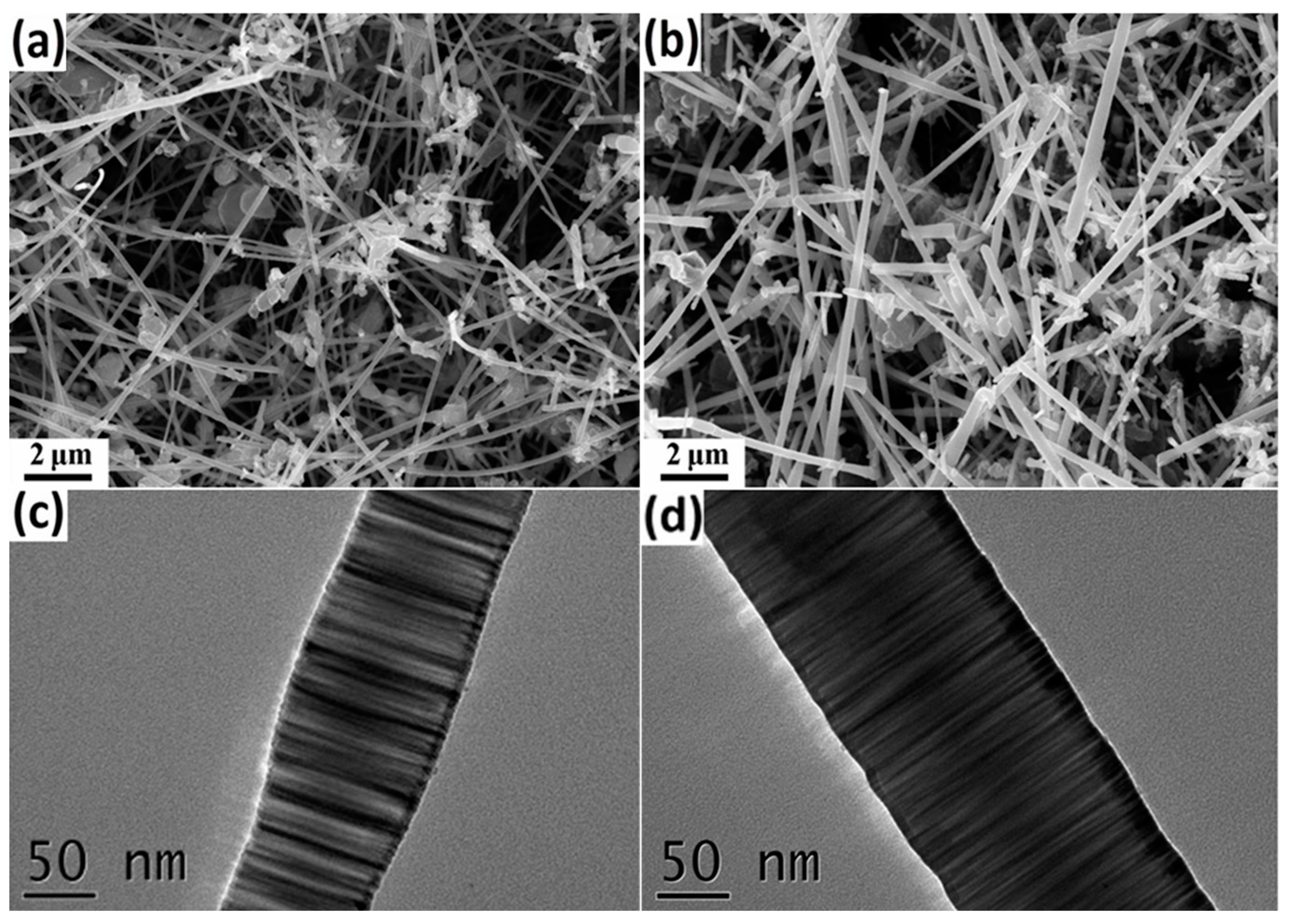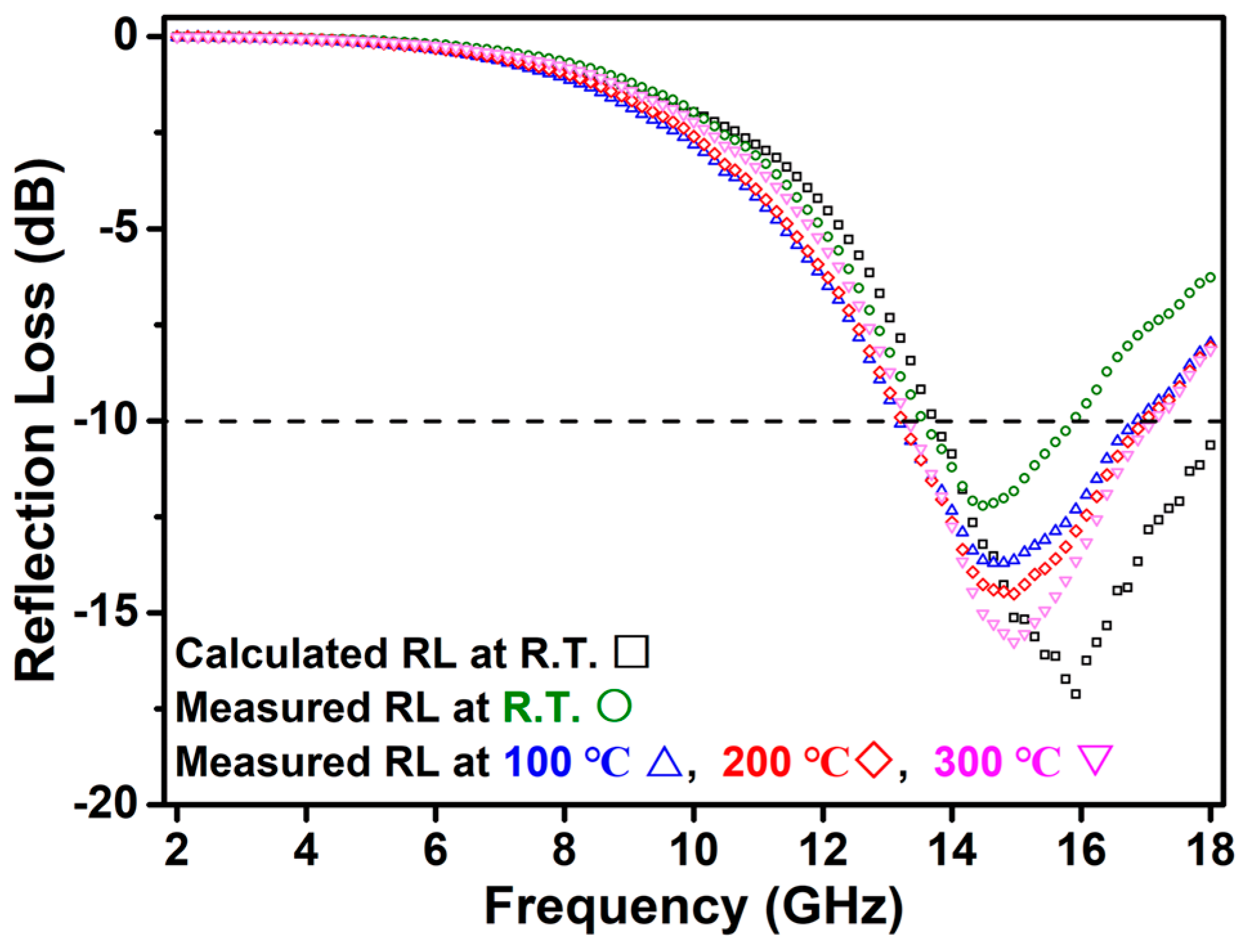Preparation and Electromagnetic Wave Absorption Properties of N-Doped SiC Nanowires
Abstract
:1. Introduction
2. Materials and Methods
2.1. Preparation of N-Doped SiC Nanowires and Composite Coatings
2.2. Characterization
3. Results and Discussion
4. Conclusions
Author Contributions
Funding
Institutional Review Board Statement
Informed Consent Statement
Data Availability Statement
Conflicts of Interest
References
- Huczko, A.; Dąbrowska, A.; Savchyn, V.; Popov, A.I.; Karbovnyk, I. Silicon carbide nanowires: Synthesis and cathodoluminescence. Phys. Status Solidi B 2009, 246, 2806–2808. [Google Scholar] [CrossRef]
- Lebedev, A.; Suzdal’tsev, A.; Anfilogov, V.; Farlenkov, A.; Porotnikova, N.; Vovkotrub, E.; Akashev, L. Carbothermal synthesis, properties, and structure of ultrafine SiC fibers. Inorg. Mater. 2020, 56, 20–27. [Google Scholar] [CrossRef]
- Xu, H.; Li, X.; Tong, Z.; Zhang, B.; Ji, H. Thermal Radiation Shielding and Mechanical Strengthening of Mullite Fiber/SiC Nanowire Aerogels Using In Situ Synthesized SiC Nanowires. Materials 2022, 15, 3522. [Google Scholar] [CrossRef] [PubMed]
- Wang, Y.; Dong, S.; Li, X.; Hong, C.; Zhang, X. Synthesis, properties, and multifarious applications of SiC nanoparticles: A review. Ceram. Int. 2022, 48, 8882–8913. [Google Scholar] [CrossRef]
- Han, T.; Luo, R.; Cui, G.; Wang, L. Effect of SiC nanowires on the high-temperature microwave absorption properties of SiCf/SiC composites. J. Eur. Ceram. Soc. 2019, 39, 1743–1756. [Google Scholar] [CrossRef]
- Yang, H.J.; Cao, W.Q.; Zhang, D.Q.; Su, T.J.; Shi, H.L.; Wang, W.Z.; Yuan, J.; Cao, M.S. NiO Hierarchical Nanorings on SiC: Enhancing Relaxation to Tune Microwave Absorption at Elevated Temperature. ACS Appl. Mater. Inter. 2015, 7, 7073–7077. [Google Scholar] [CrossRef]
- Shi, G.-M.; Ji, L.; Zhang, Y.; Wang, X.-L.; Shi, F.-N.; Yu, D.; Bao, X.-K. Tunable microwave absorption properties of B-doped SiC nanopowders prepared by arc-discharge method. J. Mater. Sci. Mater. Electron. 2021, 32, 27484–27497. [Google Scholar] [CrossRef]
- Du, B.; Qian, J.; Hu, P.; He, C.; Cai, M.; Wang, X.; Shui, A. Fabrication of C-doped SiC nanocomposites with tailoring dielectric properties for the enhanced electromagnetic wave absorption. Carbon 2020, 157, 788–795. [Google Scholar] [CrossRef]
- Kuang, J.; Xiao, T.; Zheng, Q.; Xiong, S.; Wang, Q.; Jiang, P.; Liu, W.; Cao, W. Dielectric permittivity and microwave absorption properties of transition metal Ni and Mn doped SiC nanowires. Ceram. Int. 2020, 46, 12996–13002. [Google Scholar] [CrossRef]
- Liang, C.; Qin, W.; Wang, Z. Cobalt doping-induced strong electromagnetic wave absorption in SiC nanowires. J. Alloys Compd. 2019, 781, 93–100. [Google Scholar] [CrossRef]
- Li, Z.; Zhou, W.; Luo, F.; Huang, Y.; Li, G.; Su, X. Improving the dielectric properties of SiC powder through nitrogen doping. Mater. Sci. Eng. B 2011, 176, 942–944. [Google Scholar] [CrossRef]
- Ji, L.; Wang, X.-L.; Shi, G.-M.; Shi, F.-N.; Li, Q.; Bao, X.-K. One-step arc synthesis and enhanced microwave absorption performances of Al-doped SiC nanoparticles. J. Mater. Sci. Mater. Electron. 2021, 32, 6830–6842. [Google Scholar] [CrossRef]
- Zhao, D.-L.; Luo, F.; Zhou, W.-C. Microwave absorbing property and complex permittivity of nano SiC particles doped with nitrogen. J. Alloys Compd. 2010, 490, 190–194. [Google Scholar] [CrossRef]
- Su, X.L.; Xu, J.; Li, Z.M.; He, X.H.; Wang, J.B.; Fu, C.; Zhou, W.C.; Luo, F. Preparation of N-doped SiC whisker by combustion synthesis. Adv. Mater. Res. 2011, 197, 580–583. [Google Scholar] [CrossRef]
- Yang, Z.; Li, Z.; Ning, T.; Zhang, M.; Yan, Y.; Zhang, D.; Cao, G. Microwave dielectric properties of B and N co-doped SiC nanopowders prepared by combustion synthesis. J. Alloys Compd. 2019, 777, 1039–1043. [Google Scholar] [CrossRef]
- Su, X.; Zhou, W.; Xu, J.; Wang, J.; He, X.; Fu, C.; Li, Z. Preparation and Dielectric Property of Al and N Co-Doped SiC Powder by Combustion Synthesis. J. Am. Ceram. Soc. 2012, 95, 1388–1393. [Google Scholar] [CrossRef]
- Dou, Y.K.; Li, J.B.; Fang, X.Y.; Jin, H.B.; Cao, M.S. The enhanced polarization relaxation and excellent high-temperature dielectric properties of N-doped SiC. Appl. Phys. Lett. 2014, 104, 0521021–0521024. [Google Scholar] [CrossRef]
- Su, X.; Xu, J.; Li, Z.; Wang, J.; He, X.; Fu, C.; Zhou, W. A Method to Adjust Dielectric Property of SiC Powder in the GHz Range. J. Mater. Sci. Technol. 2011, 27, 421–425. [Google Scholar] [CrossRef]
- Dong, S.; Zhang, W.; Hu, P.; Zhang, Y.; Han, J.; Luo, X. Nitrogen content dependent microwave absorption property of nitrogen-doped SiC materials annealed in N2: Opposing trends for microparticles and nanowires. J. Alloys Compd. 2018, 758, 256–267. [Google Scholar] [CrossRef]
- Rao, K.J.; Vaidhyanathan, B.; Ganguli, M. Synthesis of Inorganic Solids Using Microwaves. Chem. Mater. 1999, 11, 882–895. [Google Scholar] [CrossRef]
- Danko, G.A.; Silberglitt, R.; Colombo, P.; Pippel, E.; Woltersdorf, J. Comparison of Microwave Hybrid and Conventional Heating of Preceramic Polymers to Form Silicon Carbide and Silicon Oxycarbide Ceramics. J. Am. Ceram. Soc. 2000, 83, 1617–1625. [Google Scholar] [CrossRef]
- Agrawal, D.K. Microwave processing of ceramics. Curr. Opin. Solid St. M 1998, 3, 480–485. [Google Scholar] [CrossRef]
- Kuang, J.; Cao, W. Silicon Carbide Whiskers: Preparation and High Dielectric Permittivity. J. Am. Ceram. Soc. 2013, 96, 2877–2880. [Google Scholar] [CrossRef]
- Huang, Y.; Zhang, H.; Zeng, G.; Li, Z.; Zhang, D.; Zhu, H.; Xie, R.; Zheng, L.; Zhu, J. The microwave absorption properties of carbon-encapsulated nickel nanoparticles/silicone resin flexible absorbing material. J. Alloys Compd. 2016, 682, 138–143. [Google Scholar] [CrossRef]
- Chen, Y.; Wang, X.; Deng, C.; Yu, C.; Ding, J.; Zhu, H. Controllable synthesis of Si@ SiC plate@ Si3N4 whisker with core-shell structure and their electrochemical performances. Powder Technol. 2021, 377, 324–335. [Google Scholar] [CrossRef]
- Pyykkö, P. Refitted tetrahedral covalent radii for solids. Phys. Rev. B 2012, 85, 024115. [Google Scholar] [CrossRef]
- Tateyama, H.; Sutoh, N.; Murukawa, N. Quantitative analysis of stacking faults in the structure of SiC by X-ray powder profile refinement method. J. Ceram. Soc. Jpn 1988, 96, 1003–1011. [Google Scholar] [CrossRef]
- Zhang, H.; Xu, Y.; Zhou, J.; Jiao, J.; Chen, Y.; Wang, H.; Liu, C.; Jiang, Z.; Wang, Z. Stacking fault and unoccupied densities of state dependence of electromagnetic wave absorption in SiC nanowires. J. Mater. Chem. C 2015, 3, 4416–4423. [Google Scholar] [CrossRef]
- Kuang, J.; Cao, W. Stacking faults induced high dielectric permittivity of SiC wires. Appl. Phys. Lett. 2013, 103, 112904–112906. [Google Scholar] [CrossRef]
- Ortiz, A.L.; Bhatia, T.; Padture, N.P.; Pezzotti, G. Microstructural Evolution in Liquid-Phase-Sintered SiC: Part III, Effect of Nitrogen-Gas Sintering Atmosphere. J. Am. Ceram. Soc. 2002, 85, 1835–1840. [Google Scholar] [CrossRef]
- Nader, M.; Aldinger, F.; Hoffmann, M. Influence of the α/β-SiC phase transformation on microstructural development and mechanical properties of liquid phase sintered silicon carbide. J. Mater. Sci. 1999, 34, 1197–1204. [Google Scholar] [CrossRef]
- Turan, S.; Knowles, K.M. α→β Reverse Phase Transformation in Silicon Carbide in Silicon Nitride-Particulate-Reinforced-Silicon Carbide Composites. J. Am. Ceram. Soc. 1996, 79, 2892–2896. [Google Scholar] [CrossRef]
- Zhang, H.; López-Honorato, E.; Xiao, P. Effect of Thermal Treatment on Microstructure and Fracture Strength of SiC Coatings. J. Am. Ceram. Soc. 2013, 96, 1610–1616. [Google Scholar] [CrossRef]
- Kuang, J.L.; Jiang, P.; Liu, W.X.; Cao, W.B. Synergistic effect of Fe-doping and stacking faults on the dielectric permittivity and microwave absorption properties of SiC whiskers. Appl. Phys. Lett. 2015, 106, 4. [Google Scholar] [CrossRef]
- Zhou, W.; Li, Y.; Long, L.; Luo, H.; Wang, Y. High temperature electromagnetic wave absorption properties of Cf/SiCNFs/Si3N4 composites. J. Am. Ceram. Soc. 2020, 103, 6822–6832. [Google Scholar] [CrossRef]
- Yang, H.J.; Yuan, J.; Li, Y.; Hou, Z.L.; Jin, H.B.; Fang, X.Y.; Cao, M.S. Silicon carbide powders: Temperature-dependent dielectric properties and enhanced microwave absorption at gigahertz range. Solid State Commun. 2013, 163, 1–6. [Google Scholar] [CrossRef]






| Sample | Microwave Synthesis | Second Heat Treatment | |||
|---|---|---|---|---|---|
| Temperature × Time | Addition | Atmosphere | Temperature × Time | Atmosphere | |
| SN-A | 1500 °C × 30 min | - | N2 | - | - |
| SN-B | 1500 °C × 30 min | - | Ar | 1200 °C × 30 min | N2 |
| SN-C | 1500 °C × 30 min | NH4Cl | Ar | - | - |
| Sample | A-Lattice (Å) | Unit Cell Volume (Å3) | SF Density |
|---|---|---|---|
| Pristine SiC nanowires [34] | 4.356 | 82.65 | 2.70 |
| SN-B | 4.350 | 82.31 | 2.06 |
| SN-C | 4.352 | 82.42 | 2.34 |
Disclaimer/Publisher’s Note: The statements, opinions and data contained in all publications are solely those of the individual author(s) and contributor(s) and not of MDPI and/or the editor(s). MDPI and/or the editor(s) disclaim responsibility for any injury to people or property resulting from any ideas, methods, instructions or products referred to in the content. |
© 2023 by the authors. Licensee MDPI, Basel, Switzerland. This article is an open access article distributed under the terms and conditions of the Creative Commons Attribution (CC BY) license (https://creativecommons.org/licenses/by/4.0/).
Share and Cite
Shi, R.; Liu, Z.; Liu, W.; Kuang, J. Preparation and Electromagnetic Wave Absorption Properties of N-Doped SiC Nanowires. Materials 2023, 16, 5765. https://doi.org/10.3390/ma16175765
Shi R, Liu Z, Liu W, Kuang J. Preparation and Electromagnetic Wave Absorption Properties of N-Doped SiC Nanowires. Materials. 2023; 16(17):5765. https://doi.org/10.3390/ma16175765
Chicago/Turabian StyleShi, Ranran, Zheng Liu, Wenxiu Liu, and Jianlei Kuang. 2023. "Preparation and Electromagnetic Wave Absorption Properties of N-Doped SiC Nanowires" Materials 16, no. 17: 5765. https://doi.org/10.3390/ma16175765




